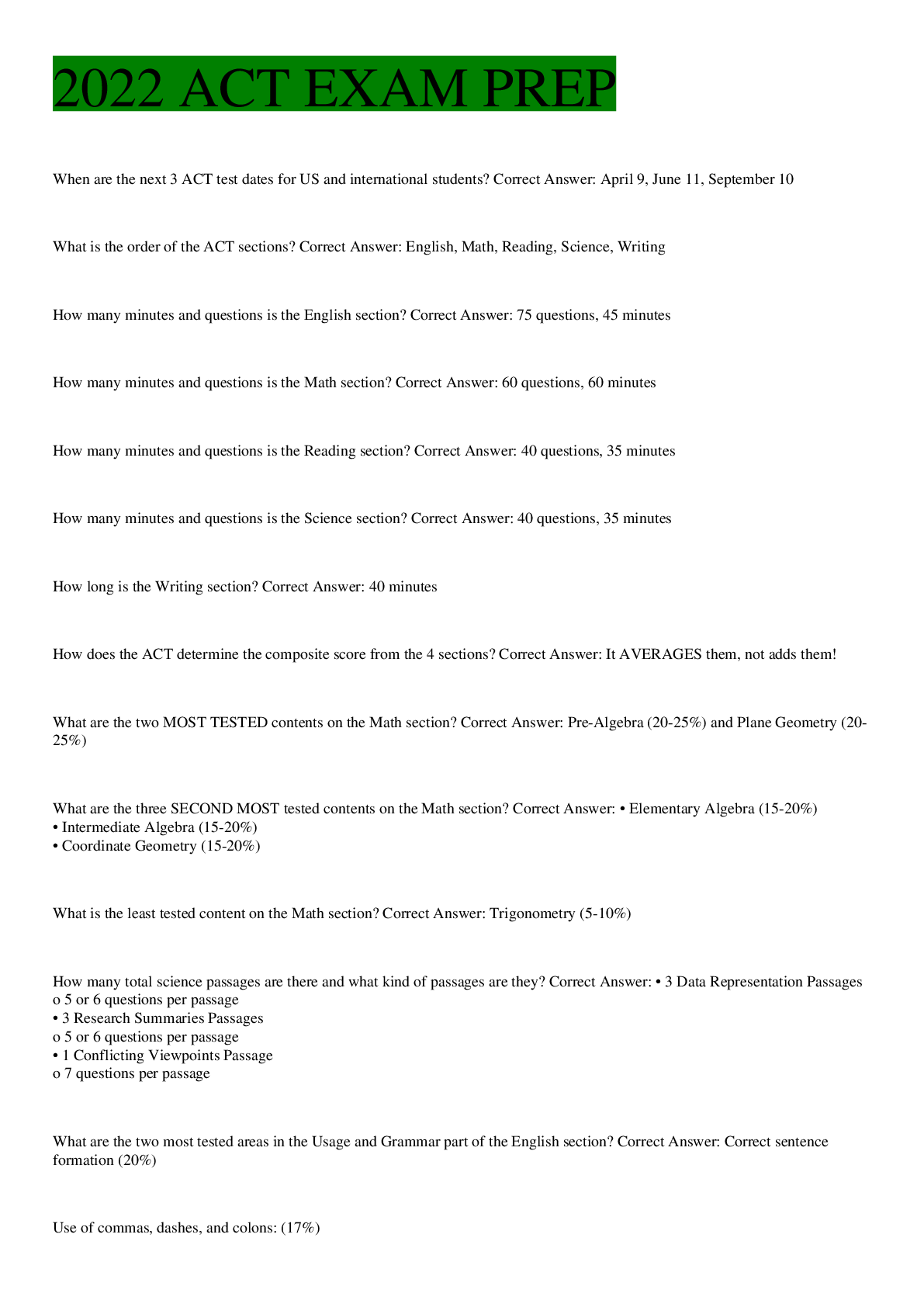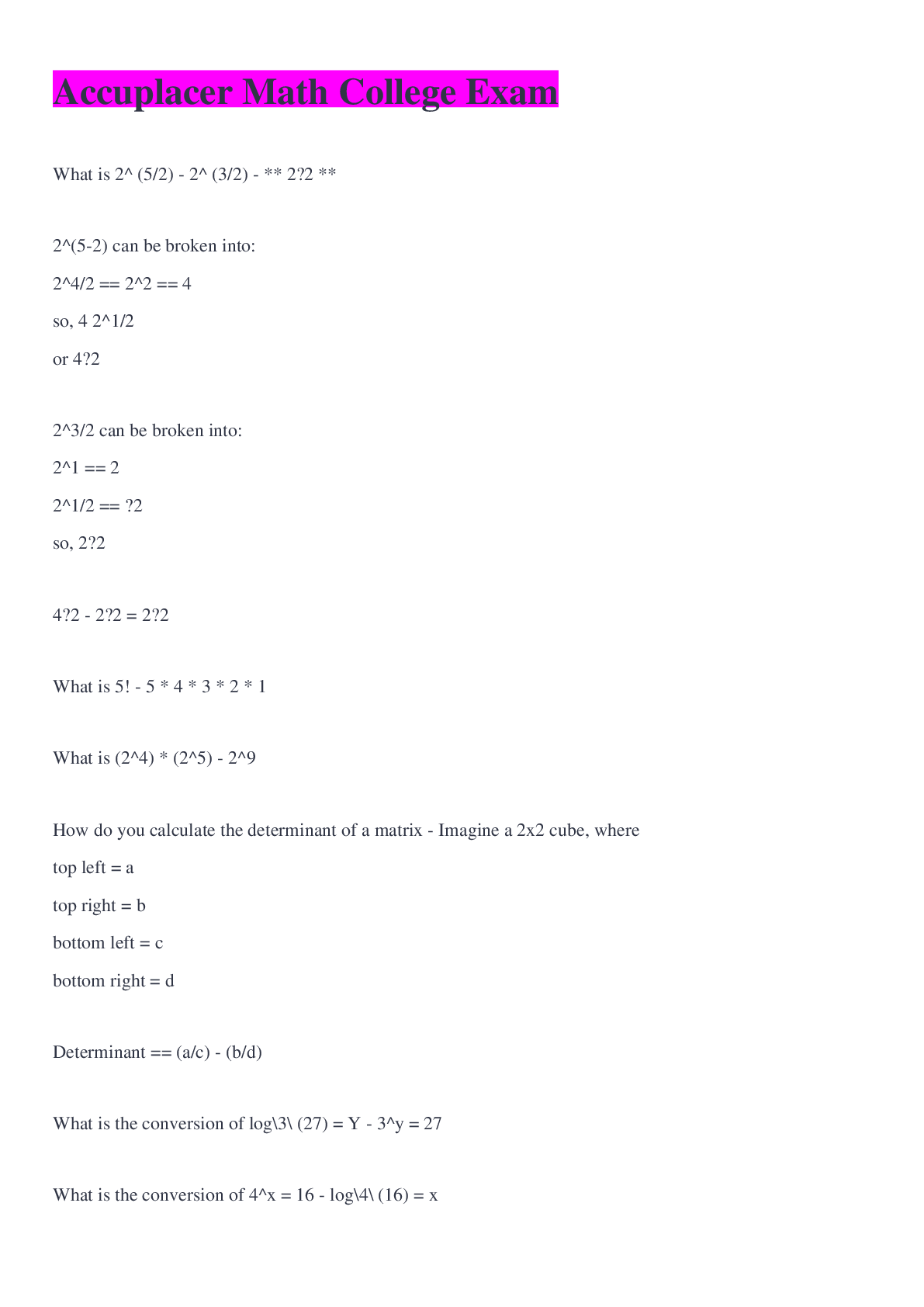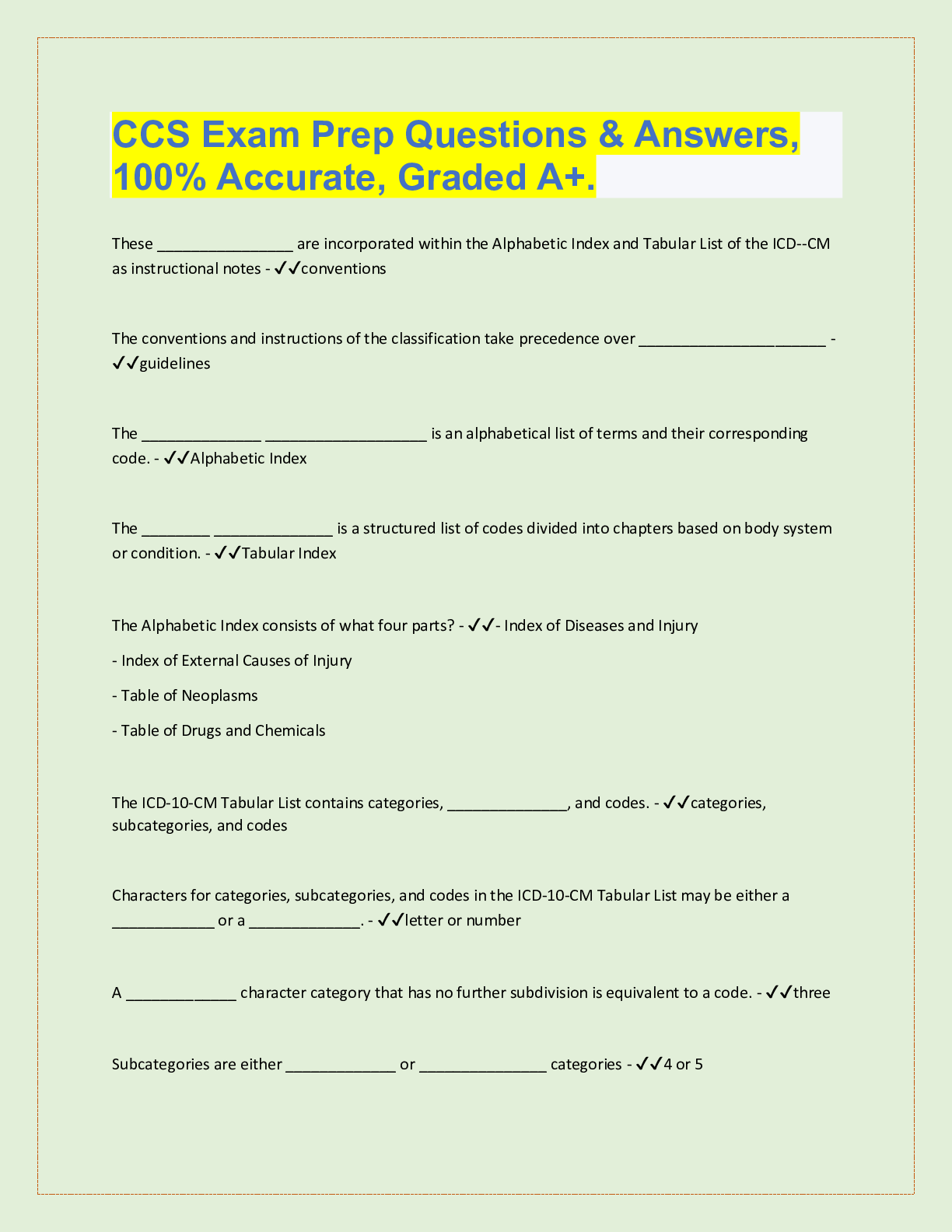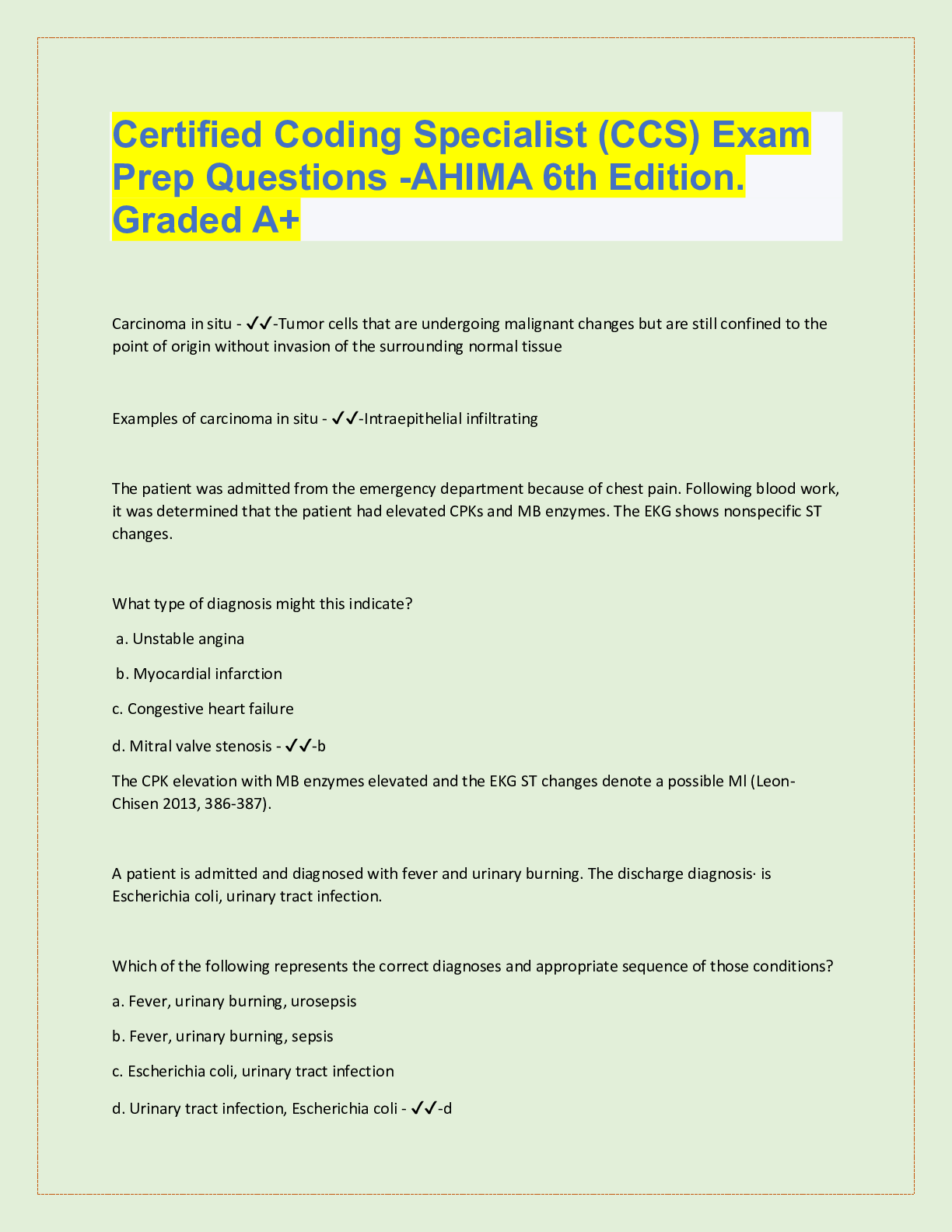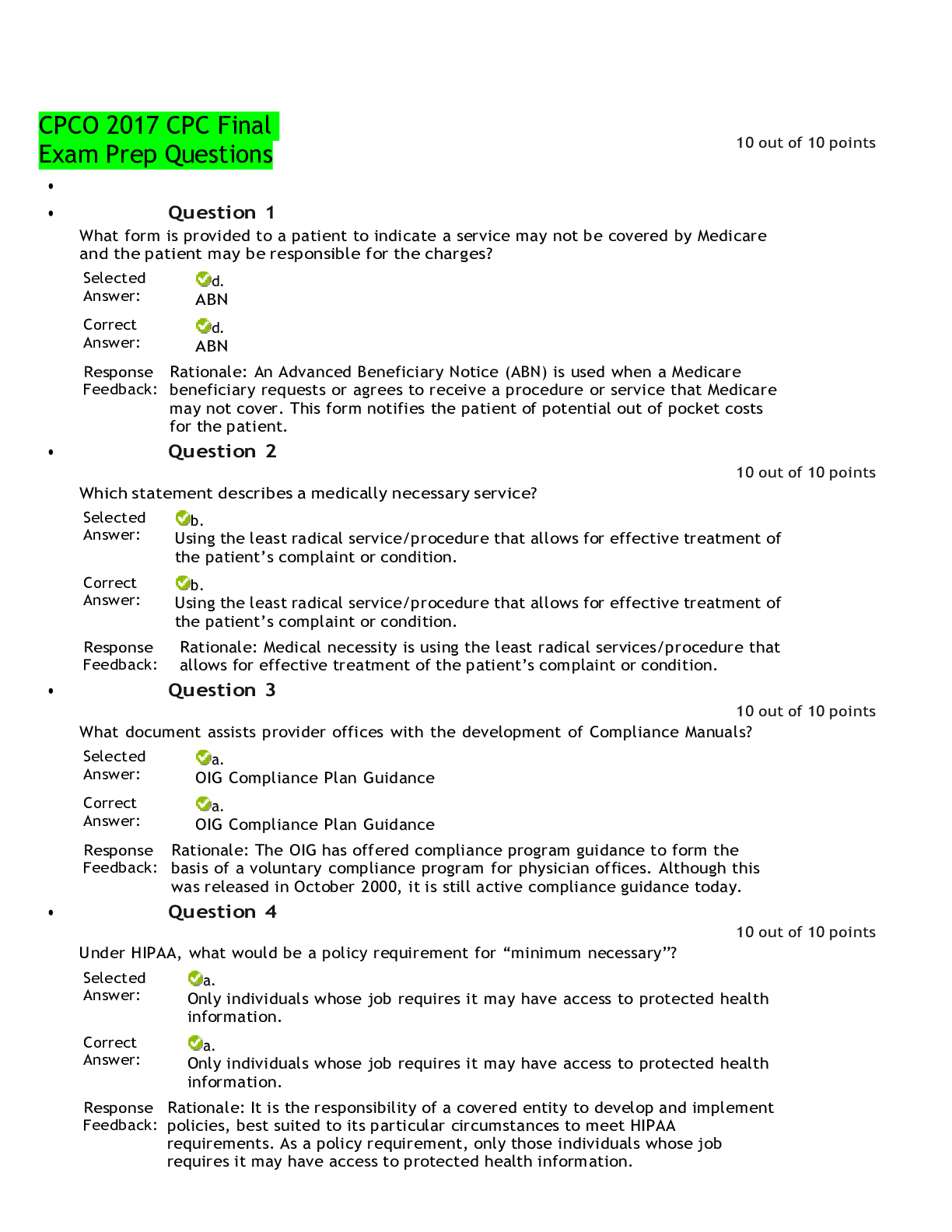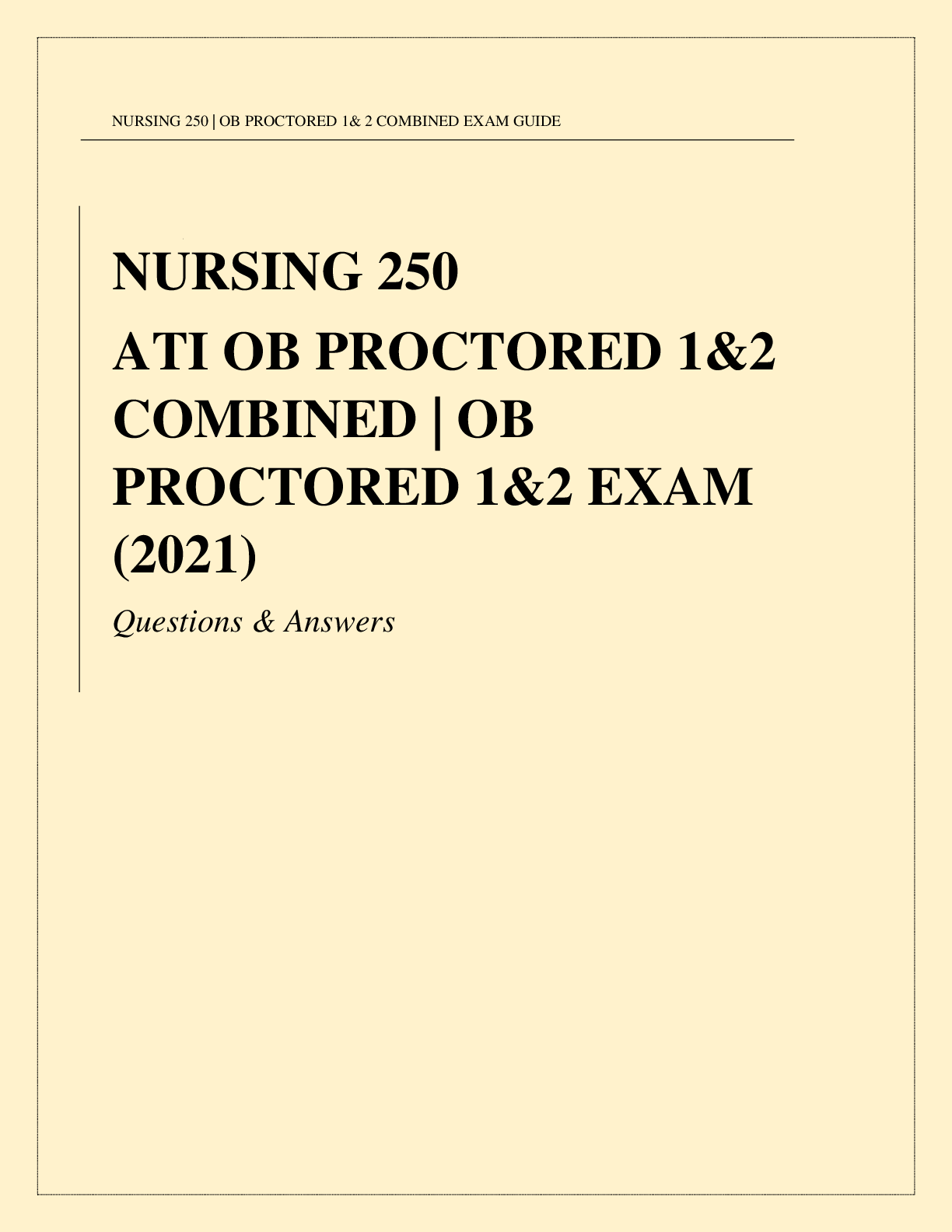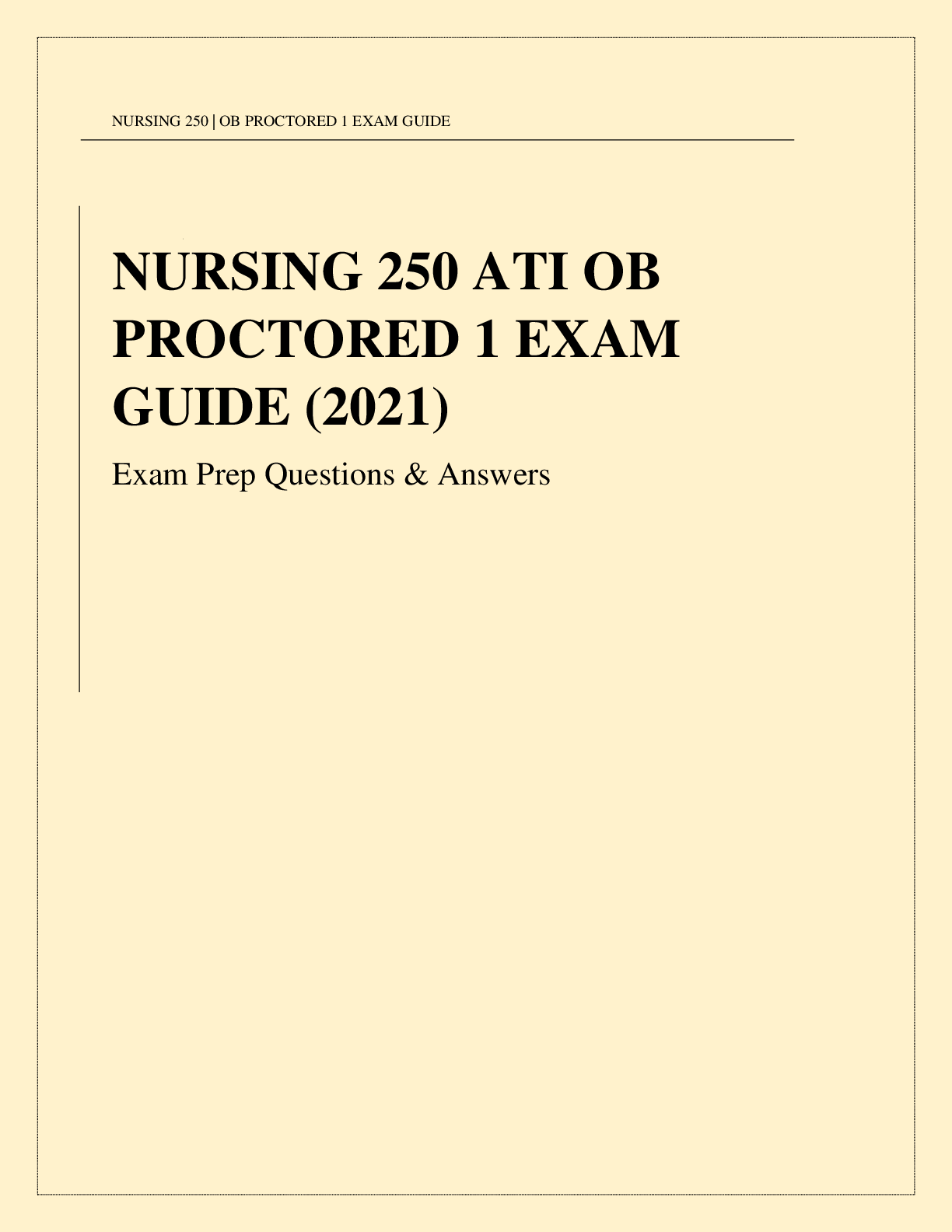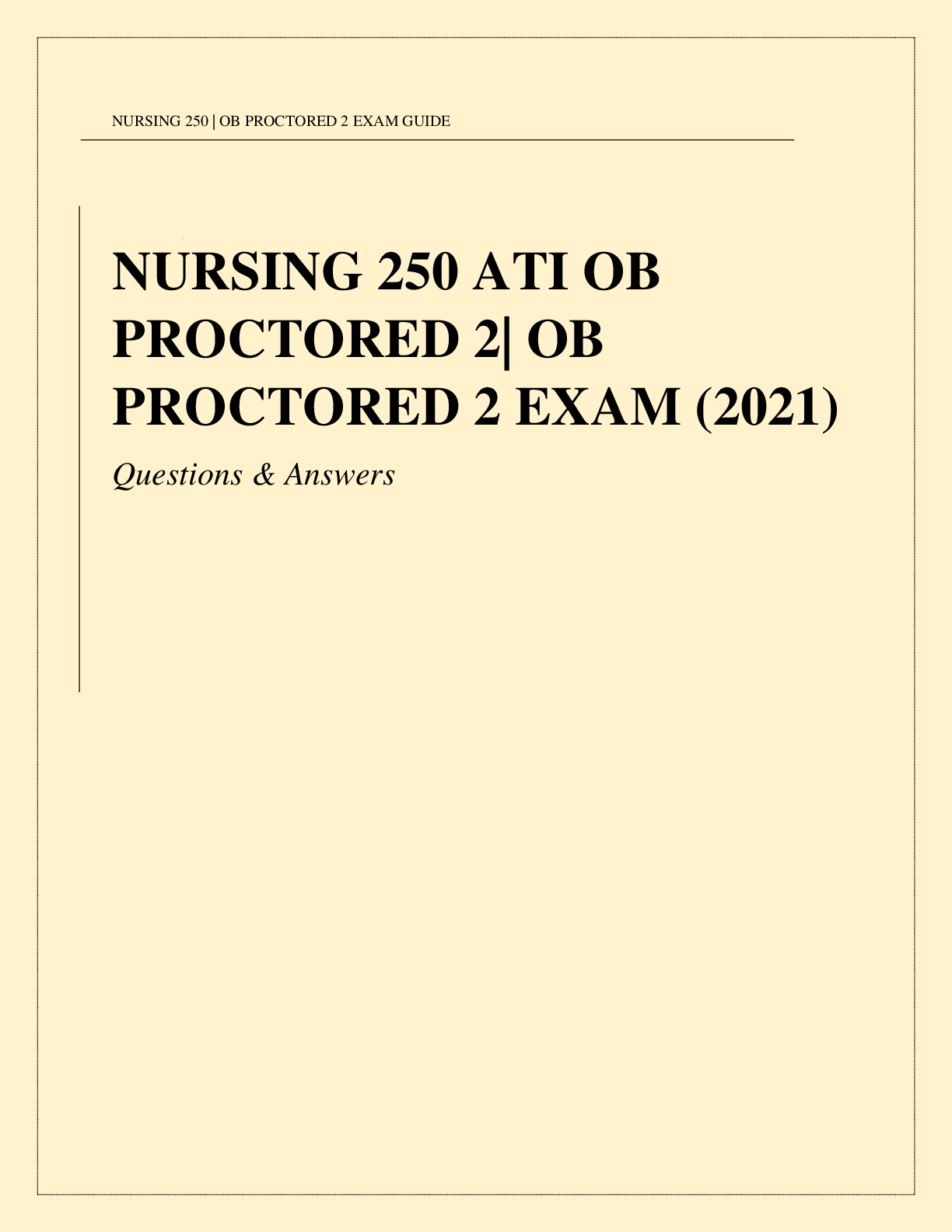*NURSING > QUESTIONS & ANSWERS > PHARMACOLOGY 2407 Exam Prep Questions with correct verified answers 2021 (All)
PHARMACOLOGY 2407 Exam Prep Questions with correct verified answers 2021
Document Content and Description Below
PHARMACOLOGY 2407 Exam Prep Questions with correct verified answers 2021 A client with renal impairment who has been taking nitrofurantoin (Macrodantin) for a urinary tract infection telephones a nu... rse and describes the recent onset of "numbness and tingling" in the fingers and toes. What should the nurse instruct the client to do? A) Discontinue the drug and come in for further evaluation. B) Continue the drug and keep the hands and feet elevated when possible. C) Check the color of the extremities every 4 hours. D) Collect a urine sample and bring it to the clinic. A client is taking trimethoprim/sulfamethoxazole (TMP-SMZ). To help the client avoid the side effects associated with this drug, the nurse should encourage the client to A) Shower twice a day B) Drink ample amounts of water C) Avoid the use of Tylenol. D) Limit citrus. B) Drink ample amounts of water A client being followed for latent tuberculosis has been on isoniazid therapy for 2 months. The nurse notes that the liver function test results have become grossly abnormal during that interval. What should the nurse do? A) Continue the drug unless jaundice, nausea, or itching develops. B) Continue the drug and have liver function tests repeated weekly. C) Hold the medication, and seek an alternative medication from the prescriber. D) Stop the drug and restart it when liver function returns to normal. C) Hold the medication, and seek an alternative medication from the prescriber. The nurse assesses a PPD on the forearm of a client being screened for employment in an outpatient clinic. The induration is 4 mm. How should this finding be interpreted? A) Negative, insignificant B) Moderately significant, requiring chest radiograph C) Moderately significant, requiring sputum culture D) Significant, requiring treatment A) Negative, insignificant The nurse is caring for a client who received an order for PO levofloxacin (Levaquin). The client is anxious to get out of the hospital, because he is a runner and wants to compete in an upcoming marathon. Which client education would be essential for this client? A) Report ringing in the ears. B) Report nausea. C) Report tendon pain. D) Report visual disturbances. C) Report tendon pain. The nurse is caring for a client who has been experiencing fever of unknown origin. The prescriber has ordered a broad-spectrum antibiotic. Which intervention is the priority? A) Administer the antibiotic immediately. B) Administer antipyretics as soon as possible. C) Obtain all cultures before the antibiotic is administered. D) Delay administration of the antibiotic until the culture results are available. A pregnant adolescent asks the nurse whether it would be all right to continue to take her prescription for tetracycline to clear up her acne. What response by the nurse provides the best information? A) "Tetracycline is effective in clearing up acne, but you should also use topical agents too." B) "Tetracycline may cause Chrohn's disease in pregnant women C) "Tetracyclines help the baby develop immunity to Lyme disease." D) "Tetracyclines could be harmful to the unborn baby's teeth. You shouldn't take them." A client has just received a prescription for a 10-day course of penicillin for the treatment of strep throat. What client education is essential for the nurse to provide? A) Family members and close contacts should also receive treatment. B) The agent should be discontinued when symptoms resolve to prevent emerging allergies. C) The entire course of the drug must be taken to prevent the re-emergence of a resistant strain. D) The medication should be discontinued if diarrhea occurs Which of these clients would be most at risk for an allergic reaction to a penicillin injection? A) A client who had a hypotensive episode following a stress treadmill study with contrast B) A client who has a history of asthma triggered by food allergies C) A client who reports an episode of hives after taking grape flavored acetaminophen D) A client who reports a history of a mild rash from penicillin taken 7 years ago A client, who is taking rifampin, telephones the nurse to say, "My urine and saliva have looked orange-red for the past 2 days." Select the nurse's best response. A) "This is consistent with an allergic response, and the drug should be stopped." B) "Continue the drug for another week to see if the color returns to normal." C) "Stop the drug, because it is likely that hepatitis has developed." D) "This is a normal effect of the drug and is harmless." A client is receiving their first intravenous infusion of vancomycin. The nurse know to watch for what unique complication of vancomycin if it infuses too rapidly? A) Pleural effusion B) Deep vein thrombosis C) Hypotension with flushing D) Constipation A client who has been receiving clindamycin for 10 days develops profuse diarrhea and abdominal pain. The nurse suspects that the client has an infection caused by C. difficile and knows to consult the prescriber about the possibility of prescribing which of these antibiotics? A) penicillin G. and trimethoprim B) vancomycin and metronidazole C) tetracycline and erythromycin D) azithromycin and nystatin The nurse administers cefotetan (Cefotan) to a client who also is taking warfarin (Coumadin). The nurse should monitor the carefully for what potential consequence? A) Increased WBCs. B) Elevated cefotetan levels. C) Bruising or bleeding gums. D) Hyperkalemia An outbreak of the flu has occurred in a long term care facility, so oseltamivir (Tamiflu) is being given to the residents on a dementia care wing? What side effect should be anticipated? A) itching B) escalation of behaviors C) twitching D) excessive thirst A client states "I'm allergic to Ampicillin. It gives my diarrhea." How should the nurse respond? A) "Diarrhea is not an allergic reaction. It is a temporary nuisance side effect. Take the pill." B) "Are there other reactions or changes you have when you take this medication?" C) "Refusal is your right. I will make a note in your chart that you don't ever want to take it." D) "Did anyone tell you that if you take it with Yogurt you can avoid that problem?" The nurse is caring for a client receiving gentamicin, an aminoglycoside, intravenously. What condition would most concern the nurse? A) Frequent voiding B) Ear pain C) Loss of appetite D) Ringing in the ears If a client is receiving tobramycin at 10:00 what time should a blood sample be obtained for determination of a trough level of the drug? A) 0800 B) 0930 C) 1030 D) 12:00 The nurse is providing education about doxycycline, a tetracycline. Which statement by the client best demonstrates understanding of the administration of this medication? A) "I will avoid taking my medication with dairy products." B) "I will need to take my antibiotic with my calcium supplements." C) "I should take my antibiotic with a calcium-based antacid to minimize gastrointestinal distress." D) "I should expect a slight, acne-like rash with this medication." Shortly after taking Ampicillin, a client arrives in urgent care with difficulty breathing. His vital signs are: respirations 34, blood pressure 94/42, pulse 26, temp 97.4 . His nurse observes hives, scratch markings and wheezes. What are the implications of these findings? A) This is a stress reaction but it will improve if the nurse applies oxygen for placebo effect. B) A mild allergic reaction is occurring but it will resolve if an antihistamine is given. C) True allergic reactions are rare, so more testing needs to be done before intervening. D) An anaphylactic reaction is occurring and emergency interventions should be A nurse is caring for a client with an infection that is being treated with tobramycin, an aminoglycoside. Which of the following findings would most concern the nurse? A) Decreased white blood cell count B) Proteinuria C) Decreased BUN D) Concentrated urine Match the following words with their definitions A. Cholinergics B. Adrenergics C. Adrenergic blockers D. Anti Cholinergics -Stimulate adrenergic receptors to enhance fight or flight response. B -Block Adrenergic receptors to suppress fight or flight response. C -Stimulate acetylcholine receptors to enhance rest digest response. A -Block Acetylcholine receptors to suppress rest digest response. D Match the following words with their definitions A. Adrenergic blockers B. Anticholinergics C. Cholinergics D. Adrenergics -Increase bowel and bladder contractility and cause salivation . A -Cause constipation, urine retention, pupil dilation and dry mouth. B -Elevate heart rate and blood pressure, open airways. C -Lower heart rate and blood pressure, can cause wheezes. D Match the following words with their definitions A. Adrenergic blockers B. Anticholinergics C. Adrenergics D. Cholinergics -Given to reverse paralysis or anticholinergic overdose. D -Given to slow bowel and bladder and dry secretions. B -Given to manage shock and open airways. C -Given to resolve hypertension or tachycardia. A Match the following words with their definitions A. Cholinergics B. Adrenergic blockers C. Anticholinergics D. Adrenergics -Give with MD present due to risk of bradycardia and wheezes. A -Contraindicated for people with glaucoma or urine retention problems. C -Watch urine output when giving as a critical drip due to nephrotoxicity. D -Hold if blood pressure below 100 systolic or if pulse is below 60. B Match the following words with their definitions A. Adrenergics B. Cholnergics C. Anticholinergics D. Adrenergic blockers -Have commode or urinal available due to bowel and bladder urgency. B -Do not feed after giving this IM or IV. Keep lights dim. C -May need interventions to calm nervousness. A -May need to institute fall precautions. D Which of these doses would the nurse question? A) Bethanechol 20mg orally T.I.D. for urine retention B) Atropine 0.5mg Intravenous, PRN bradycardia (may repeat x 1) C) Adrenalin 0.2mg (0.2 mL of 1:1000 solution) subcutaneously PRN allergic wheezing (may repeat x 1) D) Atenolol 50mg Q.I.D. orally for angina Match the following words with their definitions A. Dopamine analogues B. Neuroleptics C. Opiates D. NSAIDs -Given to manage psychotic delusions. B -Given to calm tremors in Parkinsons disease. A -Given to resolve mild pain. D -Given to manage severe pain.. C Match the following words with their definitions A. NSAIDs B. Dopamine analogues C. Opiates D. Neuroleptics -Subdues wild imagination by blocking dopamine receptors…. D -Restores balance between acetylcholine and dopamine by restoring dopamine…… B -Blocks inflammation by blocking prostaglandin cascade…… A -Subdues pain via mu and kappa receptor stimulation……….C Match the following words with their definitions A. NSAIDs B. Opiates C. Dopamine analogues D. Neuroleptics -Dyskinesias (odd motor movements) are a risk…….>D -Confusion and insomnia can occur when taken in excess…………….C -GI bleeding and renal failure can occur when taken in excess…….A -Respiratory depression and hypotension occur when taken in excess……..B Match the following words with their definitions A. NSAIDs B. Dopamine analogues C. Neuroleptics D. Opiates -Odd motor movements can occur when taking these over time…. C -People taking these medications should not take antipsychotic medications. The counteract each other…….B -Acetaminophen is a more renal friendly, GI friendly alternative to these medications….A -Naloxone is the antidote for this category of medications…… D Which of these orders would the nurse question? A) Haldol 2mg IM STAT B) Carbidopa/Levadopa 25/100 orally T.I.D. C) ASA EC 81mg daily D) Morphine 10mg sublingually now, May repeat x 1 if needed Match the following words with their definitions Benzodiazepines B. Triptans C. Acetaminophen D. Hydantoins -Prevent seizures by blocking sodium channels……….D -GABA sustaining medications used to treat insomnia………….A -Used to manage mild pain. Does not suppress inflammation………..C -Resolve migraines by stimulating of 5HT1 serotonin receptors………..B Match the following words with their definitions A. Triptans B. Benzodiazepines C. Acetaminophen D. Hydantoins -Allergic reactions or bone marrow depression are a risky side effect…. D -Dependence, tolerance, withdrawal symptoms can occur……..B -Hepatotoxic (harmful to liver) if taken in excess……..C -Can result in a lapse in cerebral circulation………A Match the following words with their definitions A. Triptans B. Hydantoins C. Benzodiazepines D. Acetaminophen -Watch serum level, CBC and check for rashes……….B -Advise no alcohol, no driving, taper slowly due to risk……….C -Watch liver enzymes. Limit to 2000mg /day for frail elders…………D -Don't give routinely, only when needed. Watch for neuro deficits………>A Which of these doses would the nurse question? A) Phenytoin 100 mg IM stat B) Lorazepam 0.5mg by mouth T.I.D prn C) Acetaminophen 650mg Q.I.D. prn D) Sumatriptan 50mg orally PRN migraine, may repeat x1 after 2 hours Match the following with its sentence A. Risperdone, an atypical neuroleptic B. Valproic acid, an antiepileptic C. Lithium, a salt D. Phenelzine, an MAOI -Taking this with traditional neuroleptics can lead to neuroleptic toxicity… A -Tyramine rich foods can cause hypertensive crisis in people taking these medicationsD -Thirst must be managed. Toxicity can cause lethal heart rhythms… C -If crushing is needed, enteric coated sprinkles should be used…….B Match the following with its sentence A. Risperdone, an atypical neuroleptic B. Valproic acid, an antiepileptic C. Lithium, a salt D. Phenelzine, an MAOI -Blocks selective dopamine receptors.. A -Sustains serotonin by preventing breakdown of monoamines……D -Sustains acetylcholine to facilitate thought transmission……..B -Sustains GABA, a naturally produced substance that calm neurons…….C -Schizophrenia: Risperdone -Depression: Phenelzine -Bipolar disorder: Lithium -Dementia: Donepezil -renal disease: Elimination -liver disease: Metabolism -peripheral vascular disease: Distribution -gastrointestinal disease: absorption A client asks what is meant by the term "first pass effect"? How would the nurse explain the term A) "It refers to the first sign that the medication is starting to work" B) "It refers to the bodies push-back response to medicines it isn't familiar with" C) It means that the liver starts to break down oral medicines before they even hit their intended receptors D) It means that the body becomes sensitized to the medicine so lower doses will be needed in the future How would a nurse explain the way pilocarpine (Salagen) would resolve related dry mouth. A) It stimulates salivation by blocking nicotinic receptors B) It stimulates salivation by stimulating muscarinic receptors C) It stimulates salivation by stimulating alpha receptors in the brain D) It stimulates salivation by redirecting fluid from the optic nerve A nurse is reviewing a client's list of medications and notices that he is taking two anticholinergics. Which of his recent symptoms could be caused by his anticholinergic medications? (Select all that apply) A) Epigastric distress B) Tachycardia C) Dry mouth D) Frequent loose stools E) Blurred vision B) Tachycardia C) Dry mouth E) Blurred vision The client diagnosed with a general anxiety disorder is prescribed alprazolam (Xanax), a benzodiazepine. Which information should the clinic nurse discuss with the client? A) Explain to the client that this medication is for short-term use. B) Inform the client that rage and excitement are expected side effects C) Tell the client to avoid foods that are high in vitamin K D) Instruct the client to take the medication before driving to avoid transit anxiety A nurse is caring for a patient who has been taking phenytoin (Dilantin) for 6 weeks. Upon review of the laboratory results, the nurse notes that the patient's phenytoin level is 18 mcg/mL. What is the nurse's best action? A) The nurse should contact the prescriber to suggest a dose increase. B) This drug level is in the therapeutic range, so the nurse can give the medicine as ordered. C) Suspect that another drug is preventing Phenytoin metabolism, and hold the causative medication. D) This drug level is too high; the nurse should contact the prescriber about reducing the dose. A 68 year old male has a history of seizures and has been taking phenytoin (Dilantin) for years. His last seizure occurred 2 years ago, so he has decided that he no longer needs the medication. What would be the best action of the nurse? (Select all that apply.) A) Recommend that he start cutting his pills in half, and see how it goes B) Affirm his plan to stop taking it, but advise that he should restart it if tremors occur C) Recommend that he develop a withdrawal plan with his prescriber D) Educate the client that suddenly stopping the drug could precipitate seizures. E) Advise the client that once a medication for seizures is started it can never be stopped. Which statement regarding the blood-brain barrier demonstrates a need for further teaching? A) "It can protect the brain from potentially toxic substance injuries." B) "It can be a significant obstacle to entry of therapeutic agents." C) "It is not fully developed at birth." D) "It lets in therapeutic agents in but filters out everything else." Which teaching point is correct with respect to the concept of "tolerance"? A) Tolerance is a state where people become used to pain, and therefore need less pain medicine. B) In tolerance, larger doses are needed to achieve prior effects because a body learns to push back. C) Tolerance occurs in slow metabolizers. Slow metabolism leads to prolonged sedation. D) When sedatives help people cope better with their suffering, we call it "drug tolerance". A nurse is caring for a client being treated with Minipress (prazosin), an alpha blocker. What counseling should the client receive? A) Rise slowly from lying to standing to avoid dizziness and a possible fall. B) Void before taking the medication to avoid urine retention C) Take a daily laxative to avoid constipation D) Avoid drinking more than 600 mls of fluid per day while taking this medication For which client would a beta adrenergic blocker be indicated? A) A client with urinary retention B) A client who suffers from diarrhea C) A hypertensive client with a heart rate of 104 D) A client who suffers from asthma The most common adverse effect associated with antiepileptic medications is CNS depression. Knowing this, which signs and symptoms would the nurse watch for during assessments? (Select all that apply!) A) Drooling B) Insomnia C) Confusion D) Hyperventilation E) Unsteady gait C) Confusion E) Unsteady gait A client with Alzheimer's disease has been taking Exelon (rivastigmine), a cholinesterase inhibitor for a week. What anticipated side effects of this cholinergic medication would the nurse anticipate? A) Numbness and tingling in the extremities B) Hypertension C) Diarrhea, urgency and possible bradycardia D) Tinnitus and hearing loss What advice should parents of a child taking Ritalin (methylphenidate) receive? (Select all that apply) A) Insomnia is a risk so give the medication in the morning B) The medication is absorbed better on an empty stomach so give in before the meal C) It is cheaper (wise) to order the medication via the internet. D) The physician must be seen every time the prescription needs to be refilled due to C2 status E) As a parent you should remain in control of this medication due to its street value F) There is no need to worry about addiction in these medications in well-adjusted children. ... The provider is considering starting a diabetic client on valproic acid (Depakote) for nerve pain this week. During the health history, the patient tells the nurse, "I drink a six pack of beer daily and two to three six packs on weekends." The priority nursing action would be to A) Obtain a lab order to assess his current level of valproic acid. B) Tell the client his alcoholism is causing his nerve pain, so medicine won't help. C) Obtain a lab order for liver function studies to determine if the prescription is safe for him D) Reassure the client that beer and Depakote are compatible A client is using a prn scopolamine patch for motion sickness. Knowing that the medication has anticholinergic side effects, the client should be taught to anticipate which side effects? (Select all that apply!) A) Urine retention B) Blurred vision C) Dry mouth D) Diarrhea E) Wheezes A) Urine retention B) Blurred vision C) Dry mouth A nurse in the emergency department is caring for a client whose family reports that she had taken an overdose of diazepam. Which of the following medications should the nurse have available to reverse the CNS depression caused by this drug? A) Ondasteron (Zofran) B) Magnesium sulfate C) Flumazanil (Romazicon) D) Protamine sulfate Before giving an adrenergic drug for wheezing, which sign would concern the nurse most? A) Pulse oximetry saturation of 88% B) Blood pressure of 110/62 C) Respiratory rate of 28 D) Irregular heart rate of 122 A nurse is taking a history on a client admitted for medication related syncope. Which of these comments from the client needs to be reported to the physician? (Select all that apply) A) "I just gave you my medication list the last time I was here. Nothing's changed! Look it up!" B) "I'm taking an herbal supplements to help me sleep, but nothing else is changes." C) "I'm taking over the counter substitutes for the medicines I can't afford. D) "I get my medicines over the internet, so I never run out of medicine. It's cheaper" E) "I wish I didn't have to bother the doctor every time I need a medication refill. F) "My cardiologist never orders anything. He just tells my regular doctor what to order." B) "I'm taking an herbal supplements to help me sleep, but nothing else is changes." C) "I'm taking over the counter substitutes for the medicines I can't afford. D) "I get my medicines over the internet, so I never run out of medicine. It's cheaper" A nurse recognizes that the actions of benzodiazepines include which of the following benefits? (Select all that apply.) A) Sleep facilitation B) Relief of general anxiety C) Suppression of seizures and/or seizure activity D) Reversal of Parkinsonism E) Improvement of muscle coordination A) Sleep facilitation B) Relief of general anxiety C) Suppression of seizures and/or seizure activity What lab value will best reflect renal function in a client taking multiple medicines? A) creatinine clearance B) potassium levels C) sodium levels D) urinalysis A client who has been taking an antiepileptic medication with a narrow therapeutic window for 2 weeks seems confused and forgetful. What should be the priority action of the nurse? A) Call the prescriber and have them change the seizure medication changed. B) Give an antihistamine like diphenhydramine under house protocol for a suspected allergy. C) Seek a plasma drug level from the client's physician. D) Set up oxygen and obtain an order for activated charcoal. An elderly person is being assessed for repeated falls. Which of their medicines increases that risk? SELECT ALL THAT APPLY! A) Halcion (triazolam), a benzodiazepine for sleep B) Acetaminophen (APAP), a peripheral analgesic for back pain C) OxyContin (oxycodone), an opiate for back pain D) Lyrica (pregabalin), a GABA sustainer for nerve pain E) Lidoderm (lidocaine) patch for local control of back pain A) Halcion (triazolam), a benzodiazepine for sleep C) OxyContin (oxycodone), an opiate for back pain D) Lyrica (pregabalin), a GABA sustainer for nerve pain A nurse is providing client education about the use of a fentanyl transdermal delivery system. Which of these statements would indicate accurate understanding of self-care expectations? A) Massage the patch whenever pain occurs B) Always apply the patch to the same spot on your skin C) Change the patch every 72 hours D) Driving is safe when using this form of narcotic A client taking paroxetine (Paxil), a serotonin reuptake inhibitor for post traumatic stress disorder, calls the clinic complaining of confusion, restlessness and fever. What should the nurse reply? A) Tell him to seek a haloperidol (Haldol) prescription from an urgent care doctor. B) Have him talk to his doctor before taking any more Paxil. These are signs of serotonin toxicity. C) Have him submit a urine specimen. He is at risk for drug induced urine retention, and UTI. D) Explain to the client that these are expected antidepressant side effects that will subside with time. The nurse reads that the half-life or morphine is roughly 3 hours. How would the nurse use this information to decide if it is safe to give Morphine every 3 hours as needed for pain? A) The half-life of Morphine shouldn't be an issue here. Pain should determine the interval" B) The half-life for Morphine shortens in states of dependence. It will be needed more often." C) The half-life of Morphine shortens over time as the liver becomes familiar with the drug. D) The half-life of Morphine would be longer in hepatic insufficiency. The drug would accumulate. Which of these effects of opiate analgesics should be considered when formulating a client care plan? SELECT ALL THAT APPLY A) Constipation B) Cough suppression C) Inflammation reduction D) Fall risk E) Fever reduction A) Constipation B) Cough suppression D) Fall risk A client experiencing loss of libido wants to know why he was started on citalopram, an SSRI, rather than one of the other types of anti-depressants?" Which response would be most appropriate? A) "Probably it is the only medication that your insurance will pay for" B) "I can't begin to guess what your doctor was thinking. You need to ask him." C) "Serotonin reuptake inhibitors have fewer side effects than other antidepressants" D) "Medications like Celexa work much faster than the other medications" A client taking amitriptyline (Elavil) complains of having blurred vision and dry mouth, and he states that he hasn't had a bowel movement in 3 days, whereas he normally has one daily. His vital signs are temperature 97.6° F, pulse 90/minute, blood pressure 130/79 mm Hg, and respirations 20/minute. Based on this assessment, the nurse should suspect which of the following causes? A) Medication incompatibilities B) Sympatholytic effects C) Dehydration D) Anticholinergic effects A client is returning to the clinic for follow-up related to elevated liver enzymes. Which of the following medications on the client's medication list would concern the nurse the most? A) Antacids routinely B) Daily antihistamines C) Acetaminophen as needed for pain D) Daily multivitamins with minerals A client who has been taking haloperidol (Haldol), a traditional antipsychotic, is now to complaining of severe muscle spasms of the eyes, neck and back. Based on these manifestations, which of these prn prescriptions could the nurse offer to help stop the symptoms? A) Benadryl (diphenhydramine) B) Motrin (ibuprofen) C) Ativan (lorazepam) D) APAP (acetaminophen) A friend of a nurse who is being treated for anxiety with a selective serotonin reuptake inhibitor wants to know why Zoloft (sertraline) is better for controlling anxiety than a benzodiazepine. Which of the following is the nurse's best response? A) "Zoloft is better for the control of physical symptoms of anxiety than benzodiazepines." B) " Zoloft provide a more rapid and durable response to the uncomfortable anxiety symptoms." C) "Benzodiazepines currently have no role in the treatment of anxiety." D) "Zoloft is better for reducing cognitive symptoms of anxiety than benzodiazepines." A depressed client is being started on phenelzine (Nardil), a monoamine oxidase (MAO) inhibitor. Which statement shows he knows the needed self-care precautions? A) "Nardil causes memory problems, but I can take Ginseng to help with that." B) "I can't drink alcohol, but caffeinated drinks and hot chocolate are fine." C) "I can have pizza as long as there is no sausage on it." D) "When I go to cookouts this summer I should eat chicken instead of hotdogs." A client who was involved in a motor vehicle accident comes into the ER distraught and complaining of leg pain. Knowing that the client is experiencing a stress response to trauma, what signs or symptoms would the nurse expect to see? A) A decrease in serum glucose B) Pupil constriction C) Elevated pulse and respirations D) Hyperactive bowel sounds A client who started an antidepressant 1 week ago tells his nurse, "I really don't think this medication is helping me." Which response by the nurse would be most appropriate? A) "Why do you think the medication is not helping you?" B) "What were you hoping would happen?" C) "You need to come to the clinic so we can discuss this." D) "Did you know that it typically takes 3 weeks for antidepressants to work?" Which adjustment in pain medication may be needed for an elderly person with elevated liver enzymes due to anticonvulsant therapy? A) A higher dose should be used with the same time schedule due to excessive enzyme counts. B) The time between doses should be expanded to allow for metabolism in hepatic dysfunction. C) The medication should be crushed to facilitate more rapid metabolism D) The time between doses should be shortened. Elevated enzyme counts will speed metabolism . Sumatriptan (Imitrex) has been ordered for an elderly client experiencing a migraine. The nurse understands that Triptan medications are contraindicated in which condition? A) Cerebrovascular insufficiency B) Chronic Lung disease C) Narcotic dependency D) Irritable bowel syndrome The nurse is preparing to administer lithium (Eskalith), to a client with bipolar disorder whose lithium level is 2.0 mEq/L. What symptoms might the nurse expect to see? (Select all that apply.) A) Irregular heart rate B) Hunger C) Slurred speech D) Unsteady gate E) Pacing F) Drooling A) Irregular heart rate C) Slurred speech D) Unsteady gate Aspirin would be detrimental in which of these situations? SELECT ALL THAT APPLY A) Client also takes anticoagulants B) Client is also pregnant C) Client also has Rheumatoid arthritis D) Client also has a peptic ulcer E) Client is a child with a fever A) Client also takes anticoagulants B) Client is also pregnant D) Client also has a peptic ulcer E) Client is a child with a fever What should the nurse do after giving a young man Dilaudid (hydromorphone) for migraine? A) Awaken him to assess his pain level. B) Explain the risks of the medication. C) Offer him something to eat. D) Provide a restful, dimly lit environment. A client with persistent pain due to cancer is brought to the emergency department by his spouse. Upon assessment, the nurse notes pinpoint pupils and a respiratory rate of 6 breaths per minute. The nurse should immediately prepare for administration of which medication? A) Naloxone (Narcan) B) Flumazenil (Romazicon) C) Methamphetamine hydrochloride (Desoxyn) D) Acetylcysteine (Mucomyst) The client has been prescribed clozapine (Clozaril), an atypical antipsychotic. Which laboratory finding should the nurse pay close attention to (since it may be altered by this medication)? A) The client's thyroid level B) The client's white blood cell count C) The client's albumin level D) The client's arterial blood gases A nurse is reinforcing instructions about the effects of diphenhydramine, an antihistamine. Which statement by the client indicates that this client needs further instruction? A) "I should avoid driving or activities requiring alertness when taking this medicine B) "I should to use sugarless gum, candy, or oral rinses to decrease dry mouth." C) "I should avoid alcohol while taking this medication." D) "I should only take this medication in the morning." A client with type I diabetes who takes insulin reports taking propranolol for hypertension. Why would this cause the nurse to be concerned? A) the beta blocker can cause insulin resistance and hyperglycemia. B) using the two agents together increases the risk of ketoacidosis. C) propranolol increases insulin requirements because of receptor blocking. D) the beta blocker can mask the symptoms of hypoglycemia. A client calls from home to report that his lispro (Humalog) insulin appears cloudy. What would be the nurse's best response? A) "Agitate the solution, and the granules should disperse." B) "Discard the vial. The solution should be clear." C) "Proceed with the injection. Drawing the solution into the syringe will mix the particles." D) "Lispro is always cloudy. Proceed with the injection." Lantus Insulin (glargine) is prescribed for a hospitalized patient who is diabetic. When will the nurse administer this drug? A) Approximately 15 to 30 minutes before each meal B) In the morning and at 4 PM C) Once daily at bedtime D) After meals and at bedtime Given these reports on clients receiving chemotherapy, which client should the nurse see first? A) The client with lightly bleeding gums B) The client with nausea and vomiting C) The client with a fever of 100.3° F D) The client with diarrhea and mouth sores Parents bring their child to the clinic because they suspect the child has pinworms. What education is most important for the nurse to provide to the parents? A) "One dose of mebendazole (Vermox) will eradicate the infestation." B) "The infestation is not easily spread." C) "Everyone in the family should be treated." D) "The treatment should be limited to symptomatic infestations." In which of these situations would the nurse question the adminstration of steroid eyedrops? A) during an eye infection B) after cataract surgery C) after a corneal abrasion D) after a chemical eye splash A client is receiving Diflucan. What should the nurse know to give this medication safely? A) It is safe to take in states of liver insufficiency but not with renal insufficiency B) It can only be given with orange juice C) It is a class D medication but breastfeeding is fine due to its short half life D) It is often only taken as a single dose because of its lingering effects A campus nurse is teaching a group of college about safe use of oral contraceptives. Which of these groups should be counseled to avoid the use of oral contraceptives? A) Women who had an abortion B) Women who have given birth C) Women who have had an IUD in the past. D) Women who smoke heavily. The nurse is caring for a client who comes to the clinic with tinea corporis, for which the prescriber orders clotrimazole. What education about this medication should the nurse provide? A) "Use the medication over the entire body once a week for 1 month." B) "Sun exposure will negate the drug's effects." C) "Continue the therapy for at least 1 week after the symptoms have cleared up." D) "This drug is effective after a single application." When metronidazole (Flagyl) is a component of the H. pylori treatment regimen, what instructions should the client receive? A) Avoid foods containing tyramine. B) Take the drug with food. C) Take the drug on an empty stomach. D) Avoid any alcoholic beverages. [Show More]
Last updated: 1 year ago
Preview 1 out of 20 pages

Also available in bundle (1)

PHARMACOLOGY 2407 PRACTICE EXAM QUESTIONS WITH ANSWERS COMPLETE 2021
PHARMACOLOGY 2407 PRACTICE EXAM QUESTIONS WITH ANSWERS COMPLETE 2021 ALLL COMBINED 5 PHARMACOLOGY DOCS
By YongSam 3 years ago
$24.5
5
Reviews( 1 )

by Mzcleanclean · 2 years ago
Document information
Connected school, study & course
About the document
Uploaded On
Feb 20, 2021
Number of pages
20
Written in
Additional information
This document has been written for:
Uploaded
Feb 20, 2021
Downloads
1
Views
110




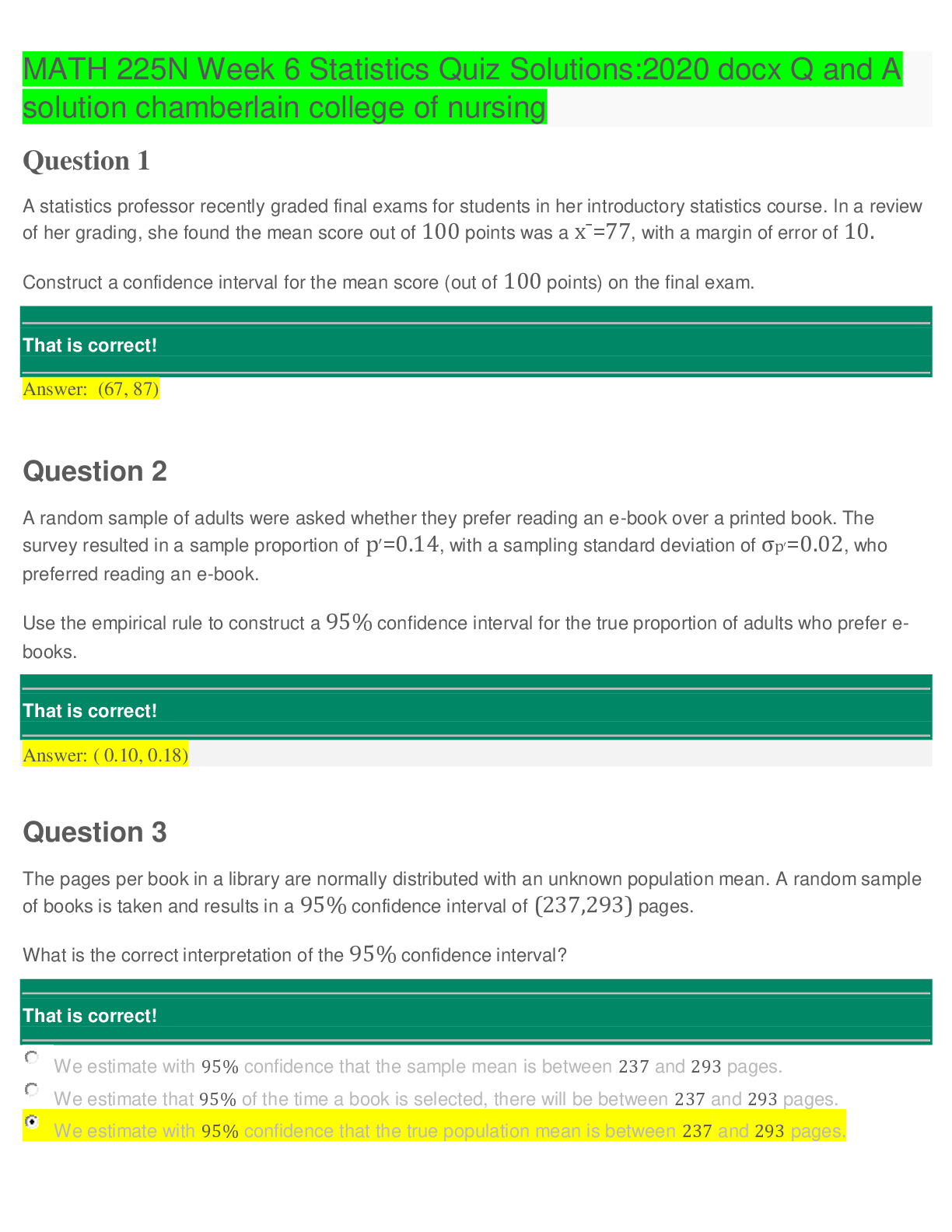

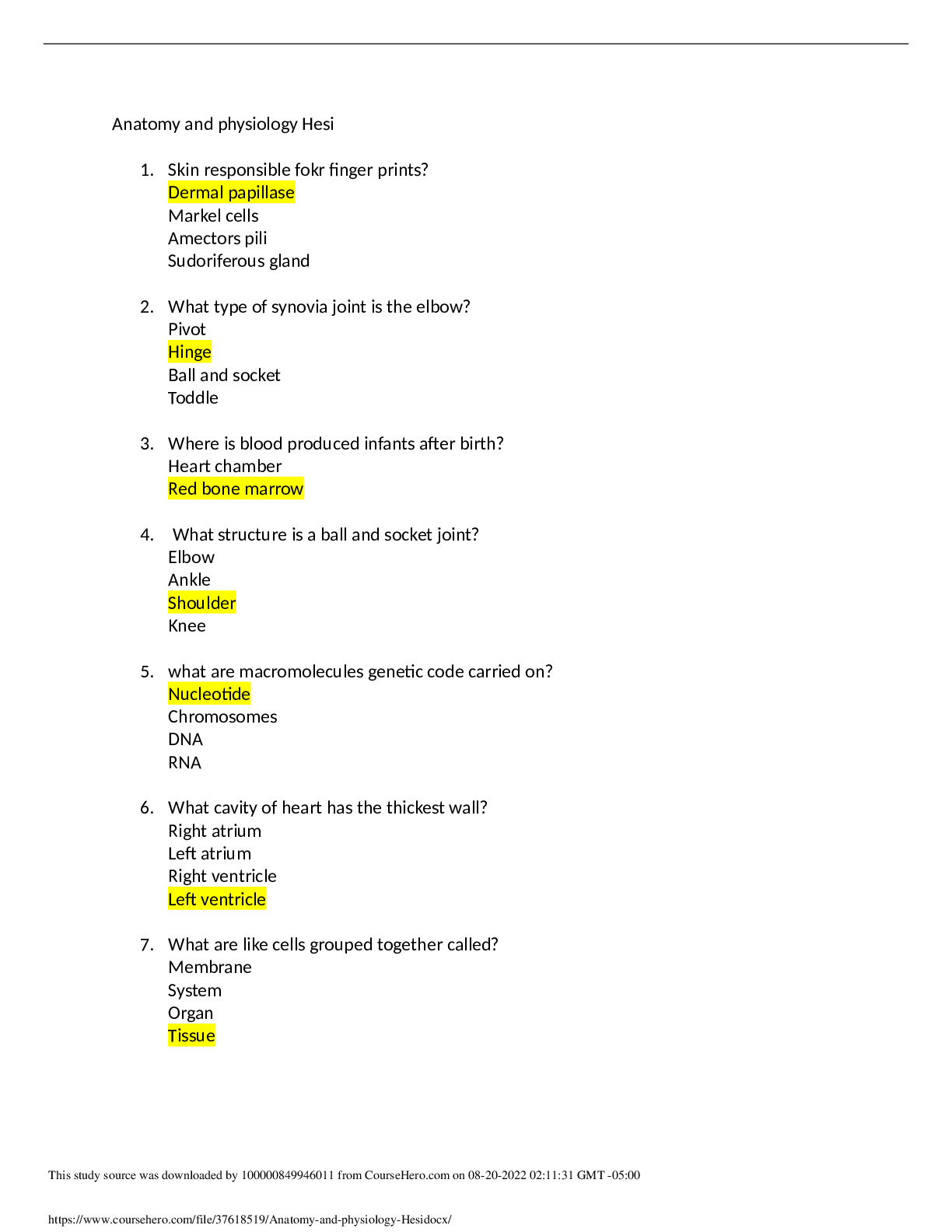

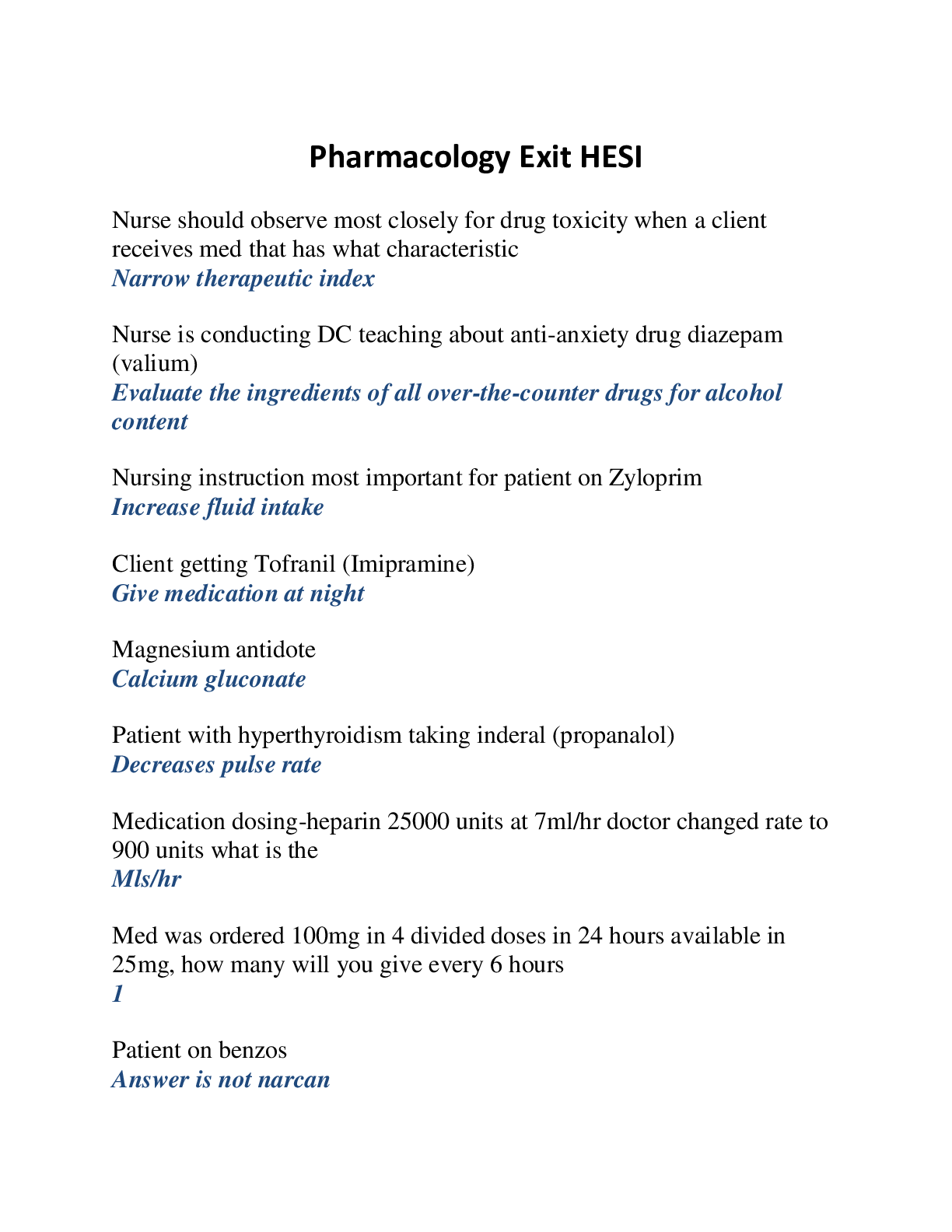
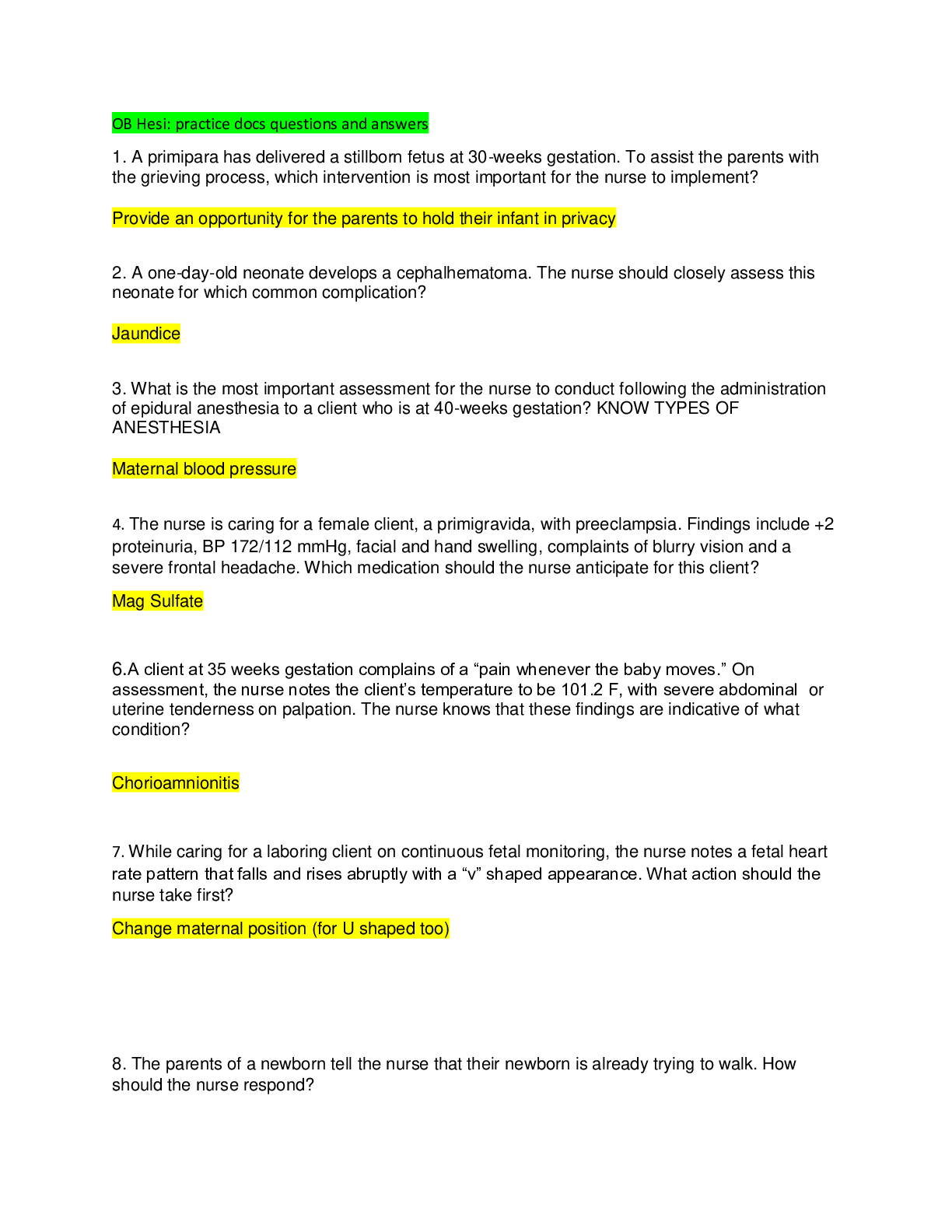
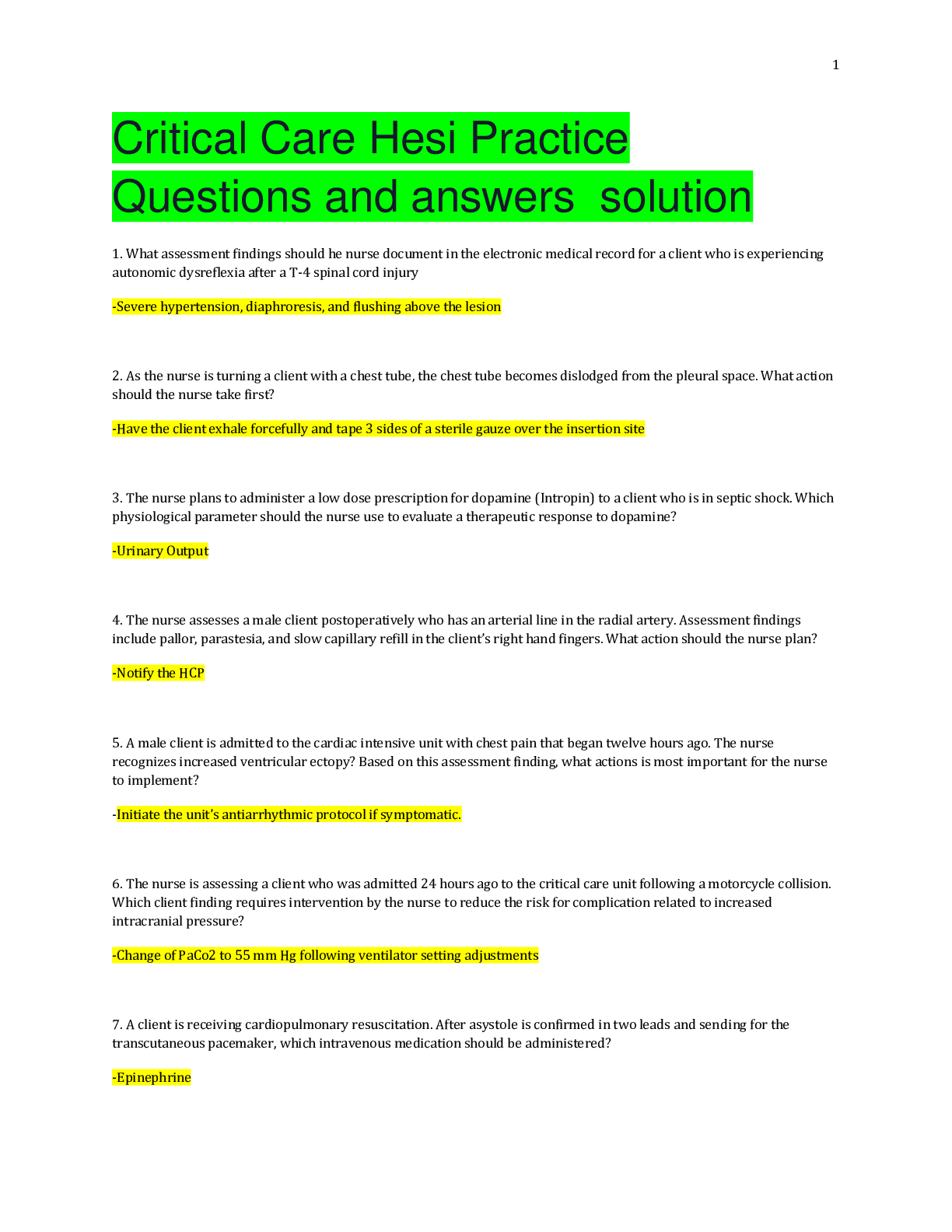
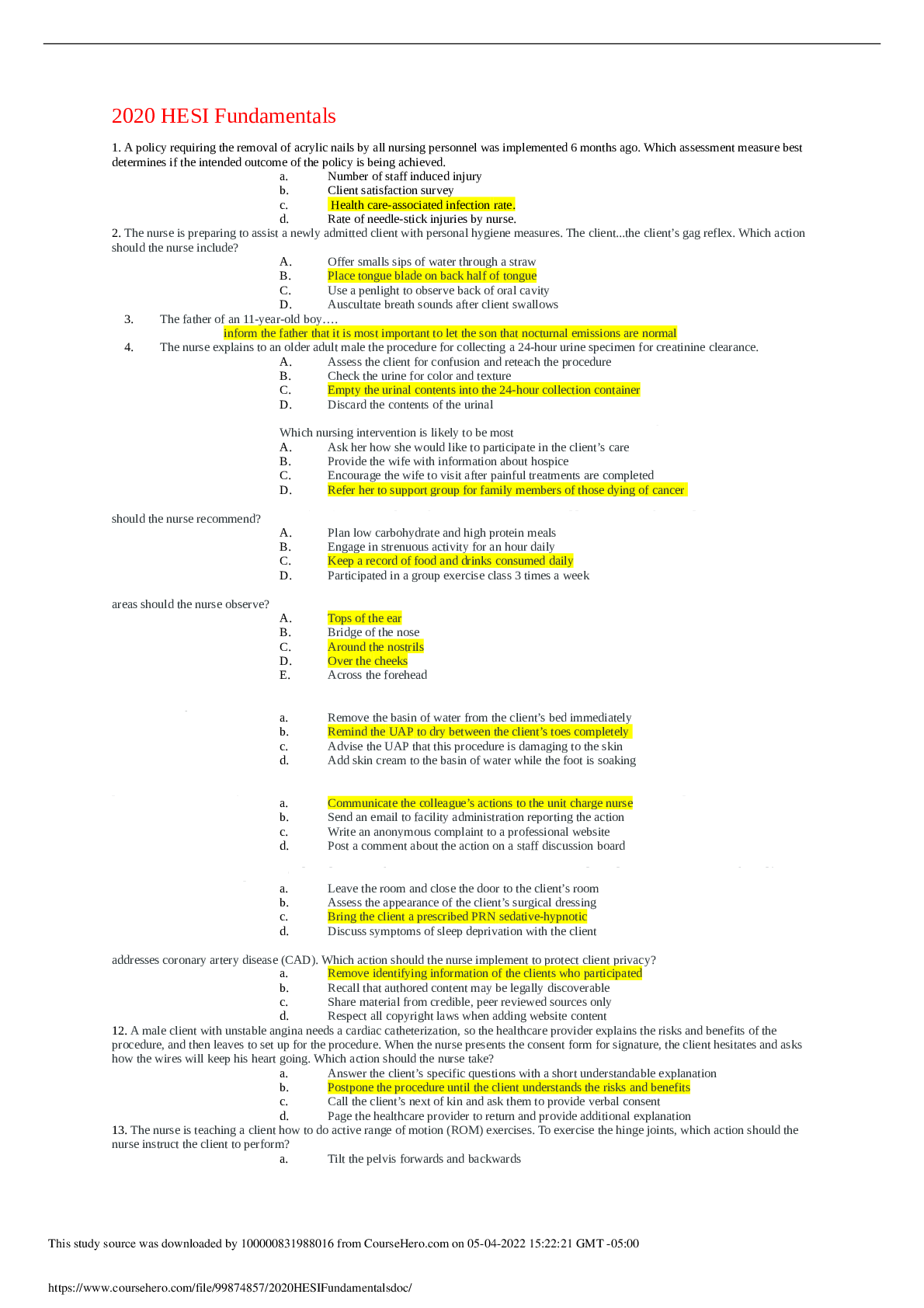

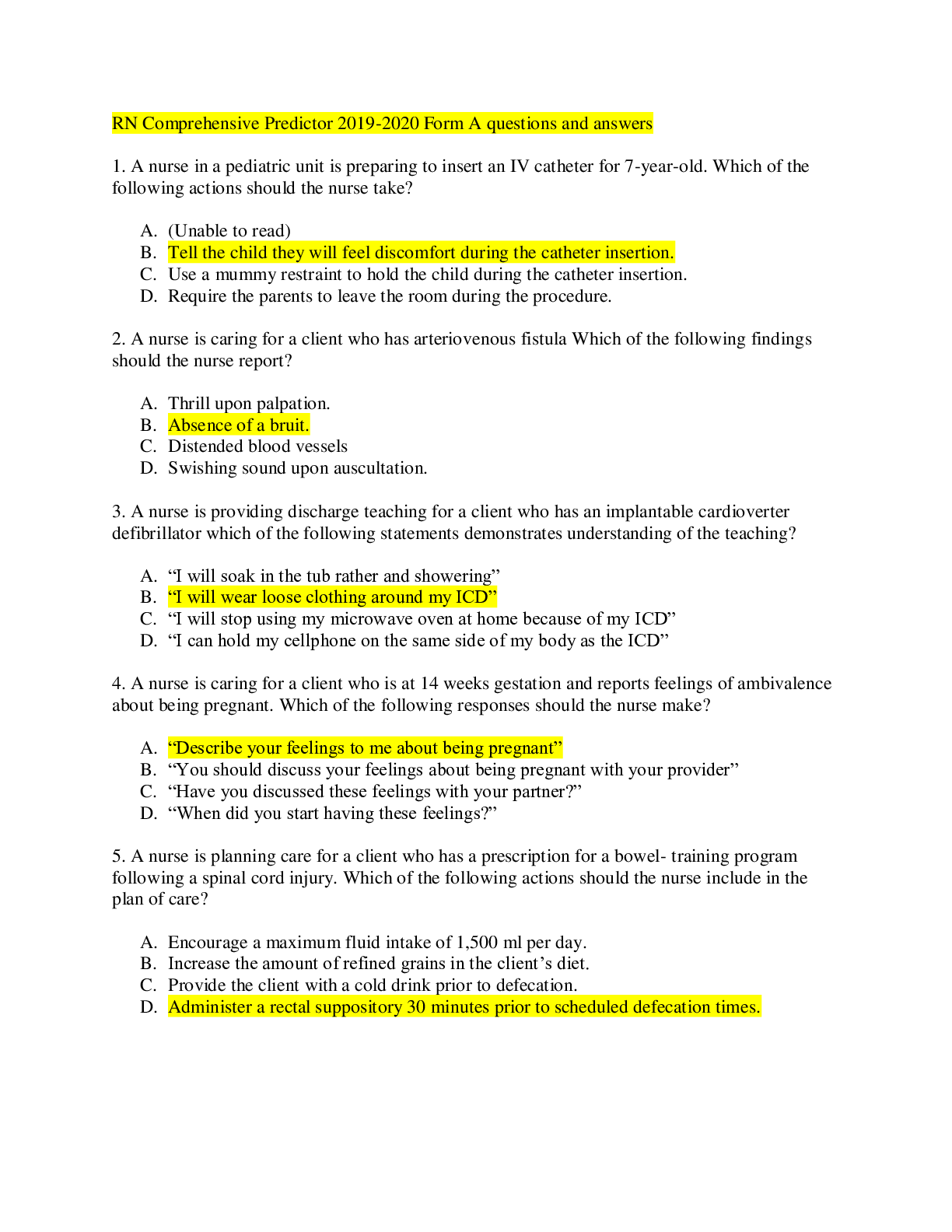

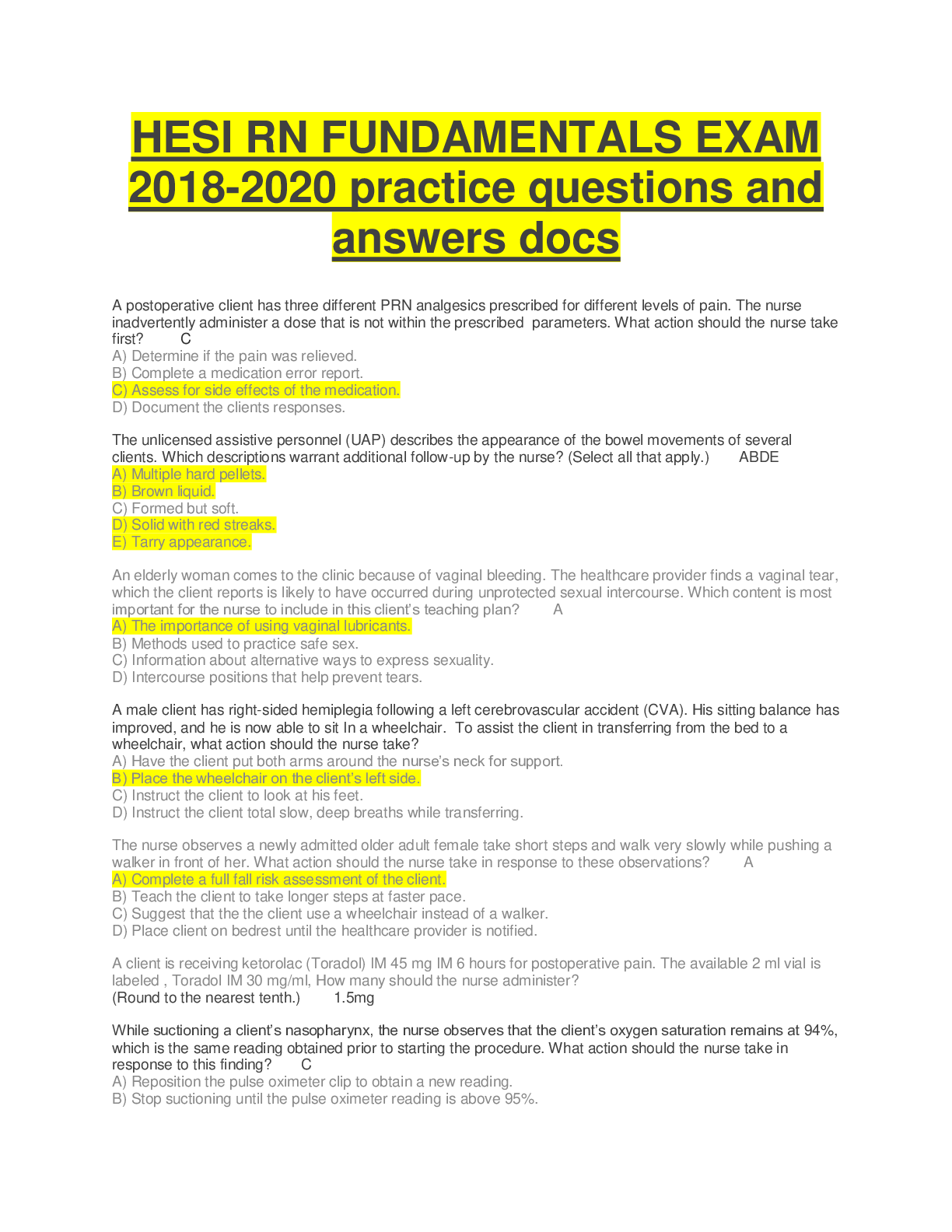
 2020 ans.png)
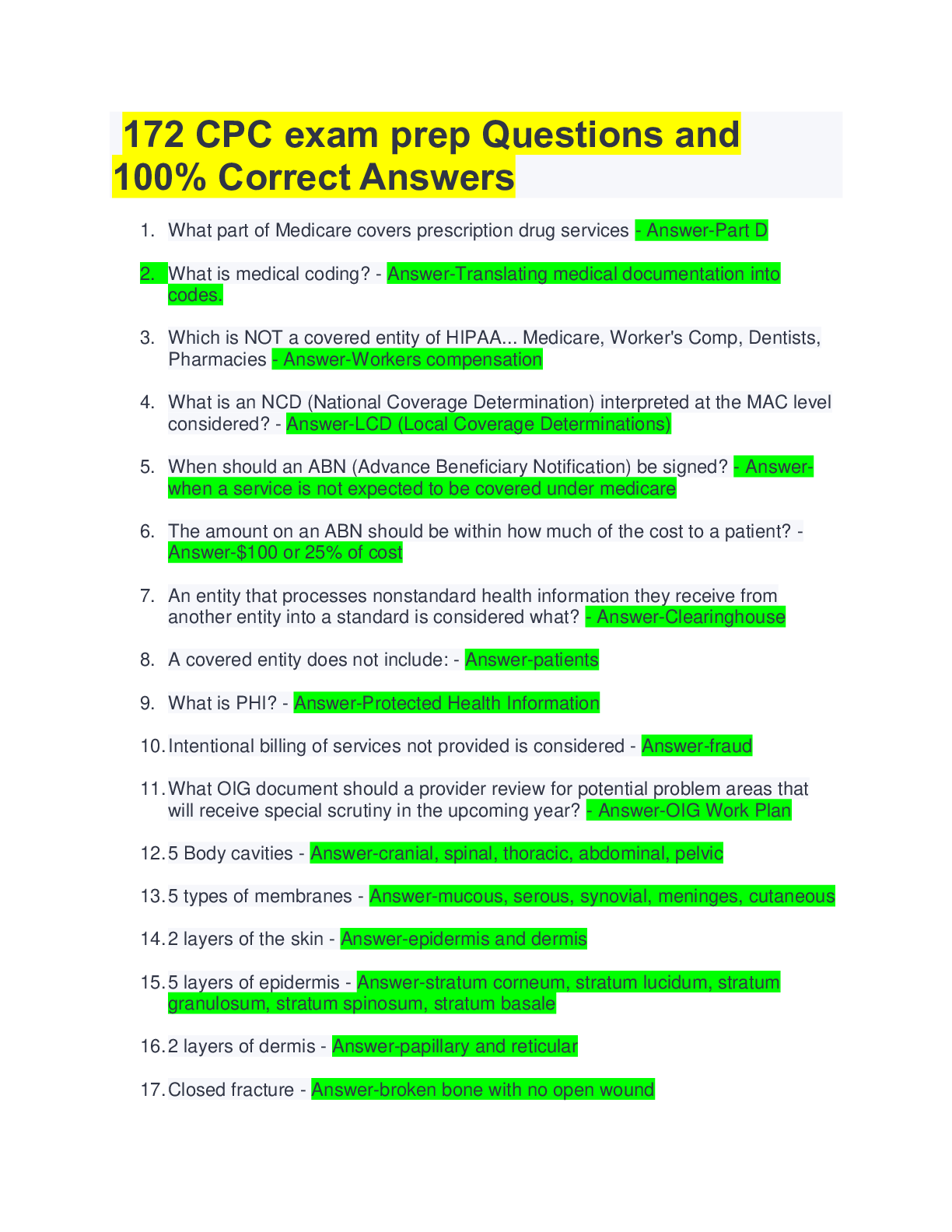

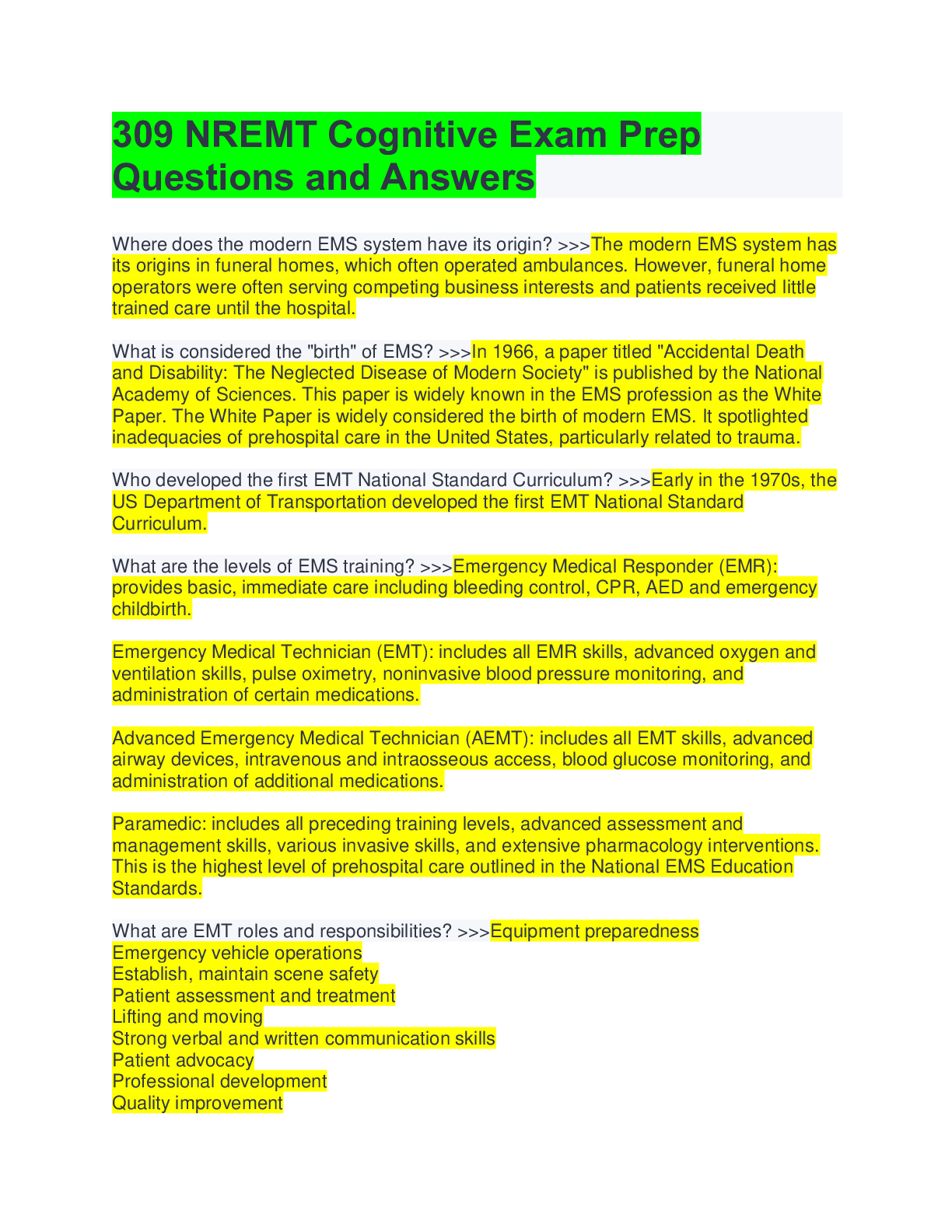
.png)
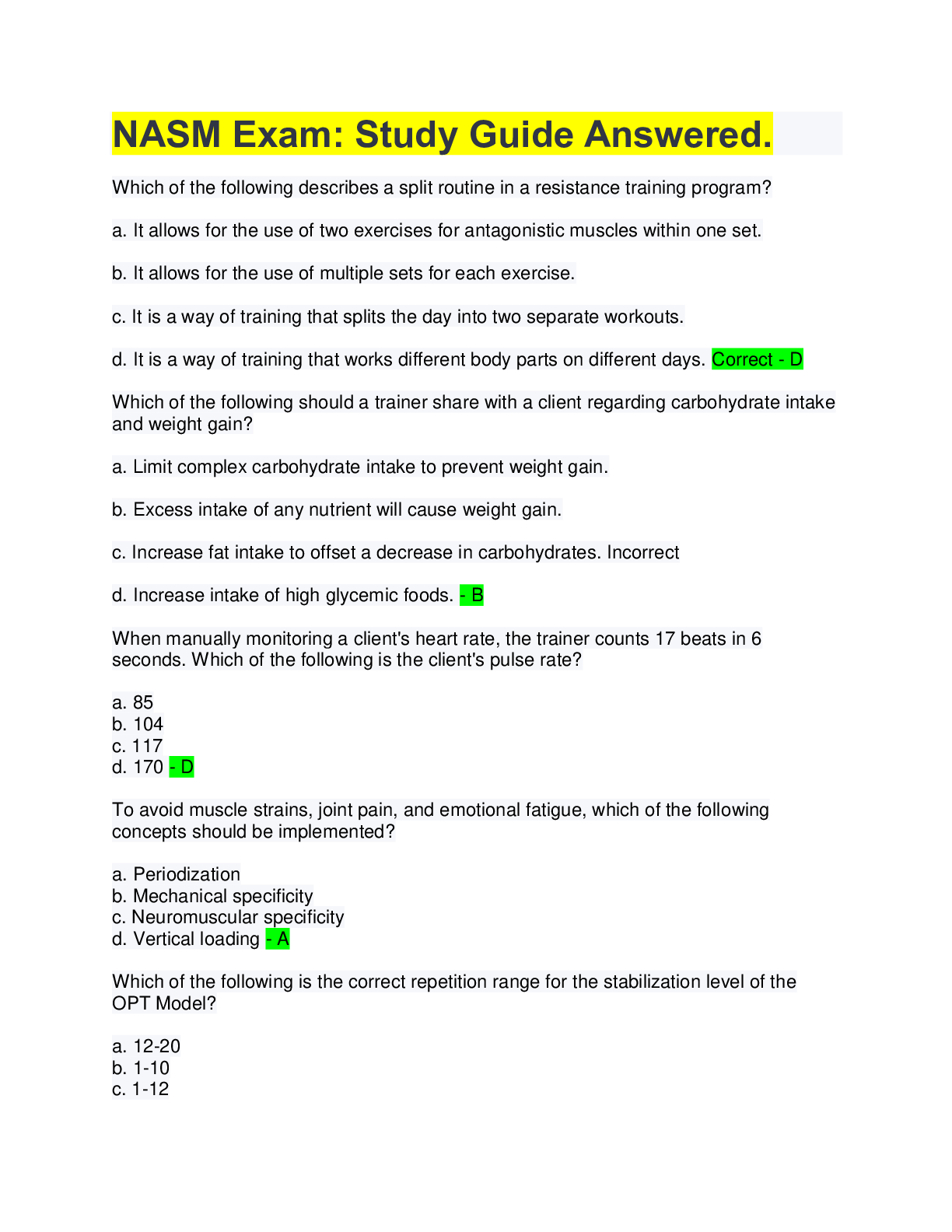
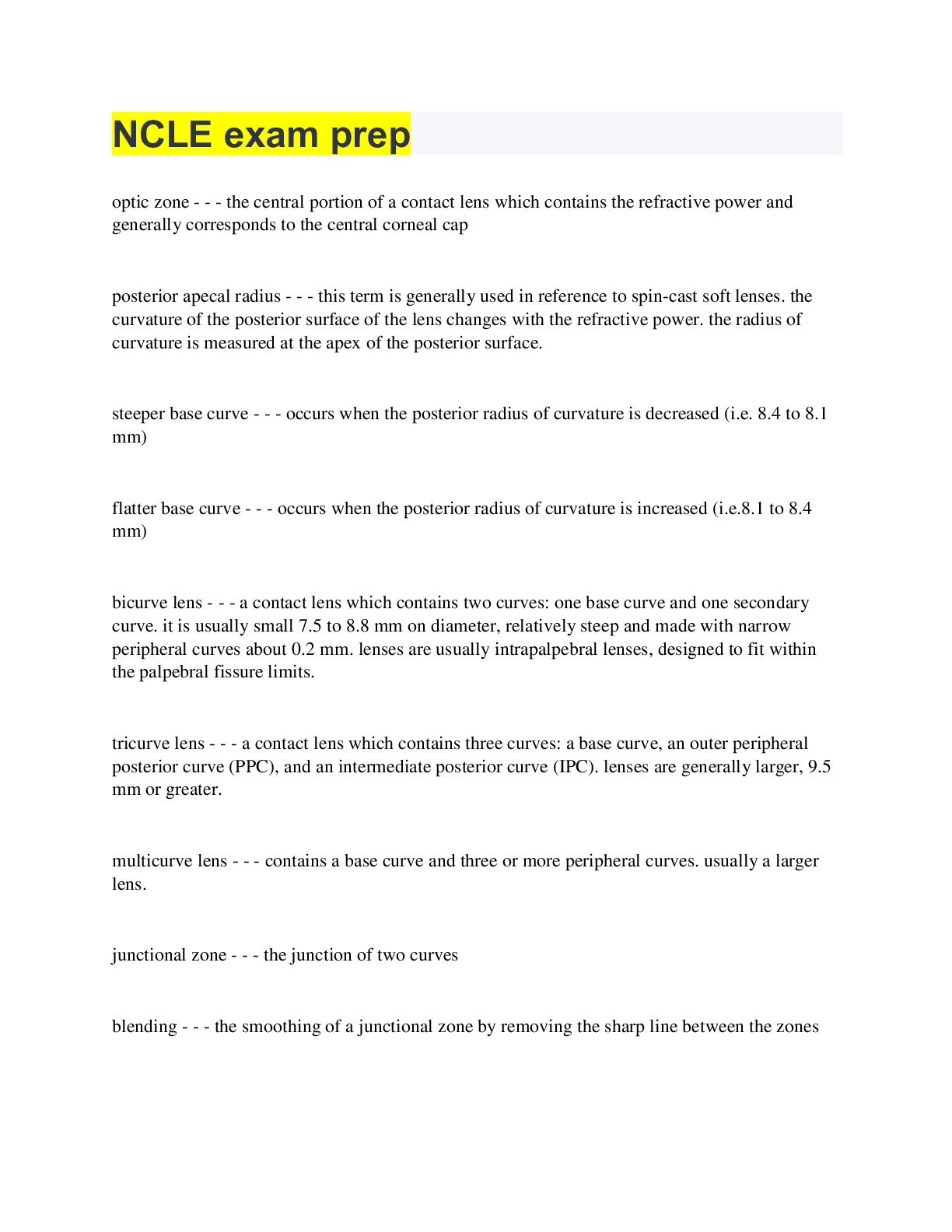
.png)
.png)
